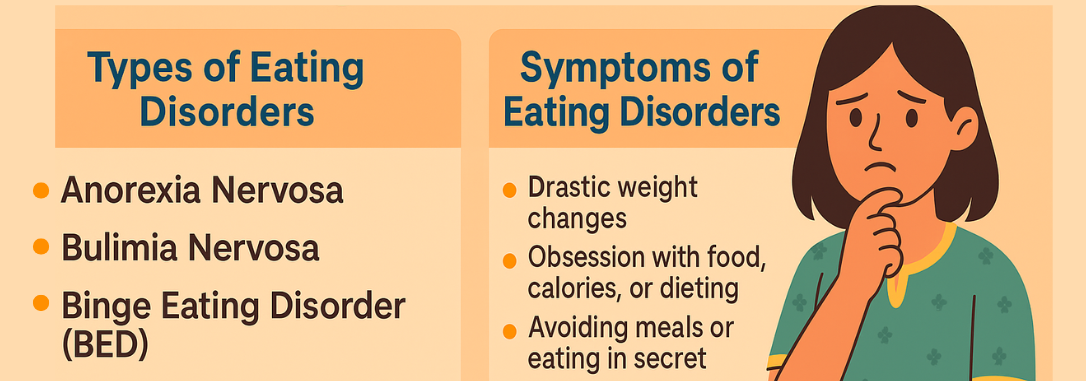
Eating Disorders Types and Symptoms in Teenagers in Pakistan
- April 23, 2025
- 0 Likes
- 1663 Views
- 0 Comments
Eating disorders are serious health conditions that affect the body and mind. In Pakistan, a growing number of teenagers are dealing with eating disorders, but the issue often goes unnoticed. Cultural pressures, academic stress, and social media influence have made many young people more vulnerable. Discussing eating disorders types and symptoms in teenagers in Pakistan is important to raise awareness and help parents, teachers, and students recognize early signs and seek timely support.
Understanding Eating Disorders
Eating disorders are mental health conditions that involve unhealthy relationships with food and body image. They often lead to serious physical and emotional problems. In teenagers in Pakistan, these disorders are becoming more common due to lifestyle changes, exposure to unrealistic body standards, and increasing academic or peer pressure. Identifying eating disorders types and symptoms in teenagers in Pakistan can play a major role in early detection and treatment.
What are the types of eating disorders?
So, what are the types of eating disorders? Among teenagers, three main types are commonly seen:
-
Anorexia Nervosa – Teenagers with anorexia have an intense fear of gaining weight. They eat very little, often skip meals, and see themselves as overweight even when they are underweight.
-
Bulimia Nervosa – Bulimia involves cycles of binge eating followed by purging. Teenagers may eat large amounts of food in a short time and then try to get rid of the calories by vomiting or using laxatives.
-
Binge Eating Disorder (BED) – This disorder includes frequent episodes of eating large quantities of food, often when not hungry. Unlike bulimia, there’s no purging involved.
These eating disorders types and symptoms in teenagers in Pakistan are often overlooked, especially in boys, due to lack of awareness and stigma.
What are 5 symptoms of eating disorders?
Recognizing early signs can save lives. What are 5 symptoms of eating disorders? Here are the most common ones:
-
Drastic weight changes – Sudden weight loss or gain without a clear reason can be a warning sign.
-
Obsession with food, calories, or dieting – Teens may constantly talk about being “fat,” even when they are underweight.
-
Avoiding meals or eating in secret – Skipping meals or hiding food habits from others is common.
-
Withdrawal from social activities – Teenagers may isolate themselves, avoiding family or friends, especially during meals.
-
Mood swings and low self-esteem – Depression, anxiety, and a poor self-image often go hand-in-hand with eating disorders.
Being familiar with these symptoms helps in identifying eating disorders types and symptoms in teenagers in Pakistan before they worsen.
What are the 4 types of eating?
You might wonder, what are the 4 types of eating? These refer to the patterns people develop with food:
-
Fuel Eating – Eating to nourish the body with healthy, balanced meals.
-
Joy Eating – Eating purely for pleasure, like desserts or snacks.
-
Fog Eating – Mindless eating without realizing it, often during TV or phone use.
-
Storm Eating – Emotional or binge eating triggered by stress or sadness.
Teenagers in Pakistan often fall into fog or storm eating, which can contribute to disordered eating habits. Understanding these behaviors helps in addressing eating disorders types and symptoms in teenagers in Pakistan more effectively.
What are the symptoms of eating disorder in men?
Eating disorders are often seen as a “female issue,” but male teenagers are also at risk. So, what are the symptoms of eating disorder in men? In Pakistani culture, these signs are harder to notice because men are expected to be emotionally strong. However, boys show symptoms too:
-
Extreme focus on fitness or body shape – This may include excessive exercise or use of supplements.
-
Secret eating habits – Similar to females, they may eat in private or hide food.
-
Mood issues – Anxiety, anger, and sadness are often linked to their eating habits.
-
Physical signs – Fatigue, stomach problems, or irregular growth patterns.
-
Social withdrawal – Avoiding friends or events due to self-consciousness about body image.
Highlighting these helps us understand eating disorders types and symptoms in teenagers in Pakistan, especially in young men who are often left out of the conversation.
Final Thoughts
Awareness is the first step toward healing. Eating disorders types and symptoms in teenagers in Pakistan need more attention in schools, families, and communities. Early intervention can prevent long-term health issues and even save lives. By recognizing symptoms, understanding eating behaviors, and supporting all genders, we can create a safer, healthier environment for our youth. It’s time to talk, listen, and act.
Need Help? You’re Not Alone
If you or someone you know is facing challenges related to eating disorders types and symptoms in teenagers in Pakistan, it’s important to know that help is available. Many families struggle in silence, but early support can make a real difference in recovery.
At Umeed, expert care and compassionate guidance are just a call or message away. The center offers specialized care for young people dealing with eating disorders in a safe and supportive setting. You can learn more about how they can help by visiting their dedicated page on Eating Disorders Support at Umeed.
Whether you’re a parent, friend, or teen looking for support, don’t hesitate to reach out. Call 0343 6004992 or email [email protected] their team is available 24/7 to assist you. Taking the first step can change a life.
